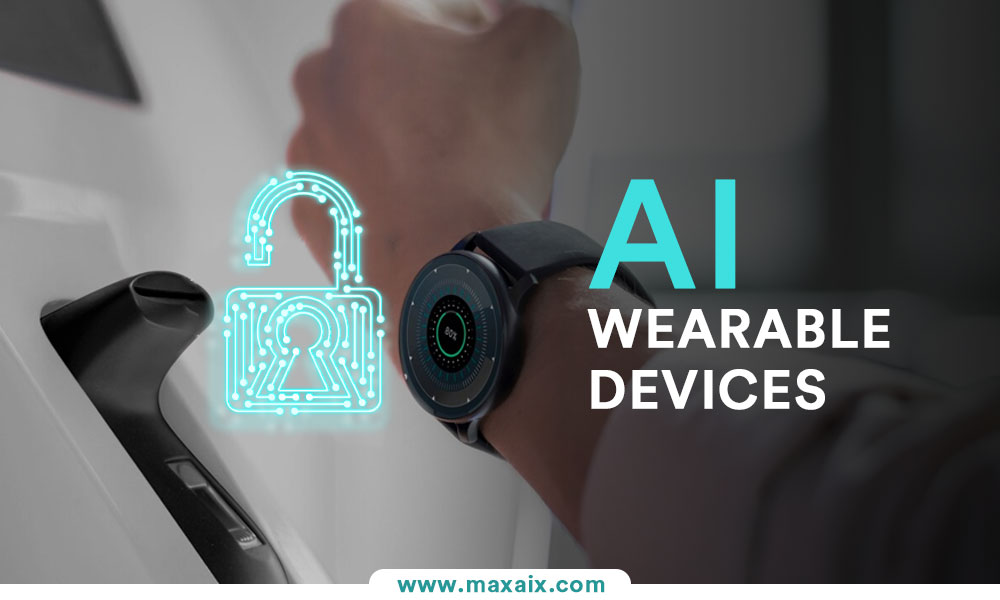Artificial Intelligence in Wearable Devices

Wearable devices have evolved significantly in recent years, and the integration of artificial intelligence (AI) has propelled them into new realms of functionality and innovation. In this comprehensive guide, we’ll delve into the world of wearable AI devices, exploring their meaning, types, applications, functionality, examples, market overview, prospects, and the associated challenges.
What is Wearable AI?
Wearable AI, or Wearable Artificial Intelligence, refers to the integration of AI technologies into wearable devices. These devices, traditionally designed for specific functions like fitness tracking or communication, are enhanced with AI capabilities to perform advanced tasks, process data, and offer intelligent insights.
What Do AI Wearable Gadgets Mean?
AI wearable gadgets represent a fusion of artificial intelligence and wearable technology. These devices leverage AI algorithms and machine learning to analyze user data, understand patterns, and deliver personalized experiences. The integration of AI enhances the capabilities of wearable devices beyond simple data tracking.
Wearable AI Devices: A Historical Overview
The evolution of wearable AI devices can be traced back to the early 21st century when basic fitness trackers emerged. Over the years, technological advancements have led to the development of sophisticated wearables that incorporate AI for tasks such as health monitoring, language processing, and contextual awareness.
Types of Wearable AI Devices
Smartwatches:
Devices like the Apple Watch and Samsung Galaxy Watch integrate AI for health monitoring, notifications, and voice assistance.
Fitness Trackers:
AI-powered fitness trackers, such as Fitbit, analyze user data to provide actionable insights for health and wellness.
Hearables:
AI-enabled earbuds, like Apple AirPods Pro, offer features such as noise cancellation and personalized audio experiences.
Smart Glasses:
Glasses like Google Glass use AI for augmented reality (AR) applications, navigation, and hands-free interactions.
Health Monitoring Devices:
Wearables like ECG monitors and smart patches utilize AI to monitor and analyze health metrics.
Smart Clothing:
AI is integrated into clothing items for health tracking, posture correction, and climate control
In What Ways May Wearable AI Devices Be Used?
Health and Fitness Monitoring:
Details: Wearable AI devices can monitor health metrics, track fitness activities, and provide insights for a healthier lifestyle.
Communication Enhancement:
Details: Language processing capabilities enable hands-free communication, voice commands, and language translation.
Navigation and Location Services:
Details: Wearables with contextual awareness can offer enhanced navigation features, including location-based alerts and guidance.
Immersive Experiences:
Details: Augmented reality integration provides immersive experiences, whether for gaming, tourism, or training.
Productivity Improvement:
Details: AI wearables can enhance productivity by offering intelligent reminders, scheduling, and task management features.
Safety and Security:
Details: Wearable AI contributes to personal safety with features like emergency alerts, fall detection, and real-time monitoring.
How Do Wearable AI Gadgets Function?
Understanding the functionalities of Wearable AI Devices is crucial for grasping their significance in our daily lives. Here are nine detailed bullet points describing how these gadgets function:
a. Sensor Integration:
Wearable AI devices incorporate a variety of sensors, including accelerometers, gyroscopes, heart rate monitors, and GPS, to collect real-time data.
b. Data Collection:
The devices gather diverse data, such as movement patterns, biometric readings, and environmental information, creating a comprehensive user profile.
c. Machine Learning Algorithms:
AI wearables use machine learning algorithms to analyze the collected data, identifying patterns, correlations, and user preferences.
d. User Interaction:
These devices enable user interaction through touchscreens, voice commands, and gesture recognition, offering seamless and intuitive interfaces.
e. Real-time Processing:
AI wearables process data in real time, allowing for instant feedback, notifications, and personalized recommendations.
f. Cloud Connectivity:
Many wearables leverage cloud connectivity to store and access vast amounts of data, enabling continuous learning and updates.
g. Personalization:
AI algorithms use user data to personalize experiences, from health and fitness recommendations to customized notifications.
h. Feedback Mechanisms:
Wearable AI devices provide feedback to users, influencing behavior, encouraging healthier habits, and fostering engagement.
i. Integration with Smart Ecosystems:
These gadgets often integrate with broader smart ecosystems, syncing data with smartphones, tablets, and other connected devices.
AI Wearable Device Examples
Apple Watch:
Details: The Apple Watch utilizes AI for health monitoring, fall detection, and contextual notifications.
Google Glass:
Details: Google Glass incorporates AI for hands-free computing, language processing, and augmented reality applications.
Fitbit Sense:
Details: Fitbit Sense employs AI for stress tracking, sleep analysis, and health insights.
Microsoft HoloLens:
Details: Microsoft’s HoloLens is an AR wearable that leverages AI for spatial mapping and interaction.
Wearable Technology Industry Shortfalls Addressed by Artificial Intelligence
Limited User Engagement:
Details: AI enhances user engagement by providing personalized content, notifications, and interactive experiences.
Data Overload:
Details: AI algorithms process vast amounts of data, offering users meaningful insights without overwhelming them.
Battery Efficiency:
Details: AI optimization contributes to better battery management, extending the device’s operational life.
Security Concerns:
Details: AI improves security with features like facial recognition, biometric authentication, and secure data encryption.
Wearable AI: What Does Digital World Meaning Follow from Implementation?
Enhanced Connectivity:
Details: Wearable AI enhances connectivity by providing seamless integration with other devices and digital services.
Personalized Experiences:
Details: Users enjoy personalized experiences through tailored content, recommendations, and interactions.
Efficient Task Management:
Details: Wearable AI streamlines task management with intelligent reminders, scheduling, and decision support.
Contextually Aware Interactions:
Details: Contextual awareness ensures that wearables adapt to the user’s environment and preferences.
What Applications Do Wearable AI Devices Find in Various Industries?
Healthcare:
Remote Patient Monitoring:
Details: AI wearables monitor patient health remotely, providing real-time data to healthcare professionals.
Assisted Living:
Details: Wearables assist elderly individuals with health monitoring, fall detection, and emergency alerts.
Retail:
Personalized Shopping Experience:
Details: AI wearables offer personalized recommendations and enhance the in-store shopping experience.
Inventory Management:
Details: Wearables streamline inventory management with AR-based tools for stock checking and product tracking.
Manufacturing:
Employee Safety:
Details: Wearable AI devices enhance safety by monitoring employee well-being and providing alerts in hazardous situations.
Quality Control:
Details: Wearables assist in quality control processes with AR-guided inspections and real-time data analysis.
Trends in AI and Wearable Technology to Stay Current
Health-focused Wearables:
Details: Increasing integration of health-monitoring features, such as ECG monitoring and blood oxygen level tracking.
AR-enhanced Experiences:
Details: Continued growth in wearables providing augmented reality experiences for gaming, education, and navigation.
Voice-Activated Wearables:
Details: Widespread adoption of wearables with voice-activated assistants, allowing hands-free control.
Enhanced Security Measures:
Details: Implementation of advanced security features, including biometric authentication and secure data transmission.
Use Cases for Wearable AI Devices
Smart Fitness Trackers:
Details: AI-powered fitness trackers offer real-time insights, personalized workout plans, and health recommendations.
Language Translation Earbuds:
Details: Wearable AI earbuds translate spoken languages in real-time, facilitating communication between individuals speaking different languages.
AR Smart Glasses for Field Technicians:
Details: Field technicians use AR smart glasses with AI capabilities for hands-free access to information, troubleshooting, and equipment maintenance.
Health Monitoring Smartwatches:
Details: AI-driven smartwatches monitor health metrics, detect anomalies, and provide health recommendations.
Wearable AI Technology and Developing AI Capabilities
Continuous Learning Algorithms:
Details: AI wearables incorporate continuous learning algorithms, adapting to user preferences, behavior, and environment.
Edge Computing for Real-time Processing:
Details: Wearable AI devices leverage edge computing to process data in real time, reducing latency and enhancing responsiveness.
AI-powered Sensors:
Details: Advanced sensors integrated into wearables are powered by AI for more accurate data collection and analysis.
Will Wearables Take the Role of Smartphones and PCs?
Complementary Roles:
Details: Wearables are unlikely to replace smartphones and PCs entirely but will complement their functions for specific tasks and convenience.
Specialized Use Cases:
Details: Wearables excel in specialized use cases such as health monitoring, AR experiences, and hands-free interactions.
Shift in Interaction Paradigm:
Details: Wearables may shift the interaction paradigm, emphasizing voice commands, gestures, and immersive experiences.
Difficulties Associated with Wearable Device AI Integration
Battery Life Challenges:
Details: The integration of AI functionalities can impact battery life, requiring optimization for energy-efficient operation.
Data Privacy Concerns:
Details: Wearable AI devices collect sensitive user data, raising concerns about data privacy and security.
User Acceptance:
Details: Convincing users of the benefits and necessity of AI wearables may pose challenges, requiring effective communication.
A Grasping Overview of the Market for AI-Based Wearable Devices
Growing Market Demand:
Details: The market for AI-based wearables is expanding, driven by increasing consumer awareness, technological advancements, and innovative applications.
Diverse Product Offerings:
Details: A variety of AI wearables are available, catering to different needs such as health, communication, entertainment, and productivity.
Competitive Landscape:
Details: Leading tech companies and startups are actively contributing to the competitive landscape, introducing new features and form factors.
AI-powered Wearables in the Future
The future of AI-powered wearables holds exciting possibilities, with advancements poised to redefine user experiences. Anticipated developments include:
- Enhanced Health Monitoring: AI wearables will provide more accurate health insights, with the potential for early disease detection and prevention.
- Augmented Reality Evolution: Smart glasses and AR wearables will see improved capabilities, offering more immersive and interactive experiences.
- Expanded Use in Industries: AI wearables will find applications in various industries, from manufacturing and logistics to healthcare and education.
- Greater Energy Efficiency: Future wearables may leverage AI for energy-efficient operations, extending battery life and reducing environmental impact.
- Innovative Form Factors: Wearables may evolve beyond traditional designs, adopting new form factors and materials for increased comfort and functionality.
Concluding
The integration of artificial intelligence into wearable devices marks a transformative era in technology, enhancing the way we interact with and benefit from our gadgets. As AI-powered wearables continue to evolve, they offer unprecedented opportunities for personalization, efficiency, and innovation across various domains.
Frequently Asked Questions
Q1: Can AI wearables operate independently, or do they rely on connected devices?
Answer: While some AI wearables operate independently, many benefit from connectivity with smartphones or other devices to enhance functionality, sync data, and access cloud services.
Q2: How secure is the data collected by AI wearables?
Answer: Data security is a significant concern, and manufacturers employ encryption, secure authentication, and adherence to privacy standards to protect user data from unauthorized access.
Q3: Are there limitations to AI wearables in terms of accuracy?
Answer: The accuracy of AI wearables depends on factors such as sensor quality, algorithm complexity, and data quality. Manufacturers continually strive to improve accuracy through technological advancements.
Q4: Can AI wearables be customized to individual preferences?
Answer: Yes, one of the key advantages of AI wearables is their ability to personalize experiences based on individual preferences, habits, and usage patterns.
Q5: How can AI wearables contribute to healthcare?
Answer: AI wearables in healthcare can monitor vital signs, detect anomalies, and provide early warnings, contributing to preventive care, chronic disease management, and overall health and wellness.
Q6: What role does machine learning play in AI wearables?
Answer: Machine learning enables AI wearables to analyze data, identify patterns, and make predictions or recommendations. It contributes to the adaptability and intelligence of these devices.
Q7: Are there ethical considerations related to AI wearables?
Answer: Ethical considerations include user privacy, data consent, and transparency in data usage. Manufacturers and developers are increasingly focusing on ethical practices to address these concerns.
Q8: Can AI wearables replace traditional medical devices?
Answer: While AI wearables show promise in healthcare applications, they are not intended to replace traditional medical devices entirely. They can complement existing tools and provide additional insights for both users and healthcare professionals.


